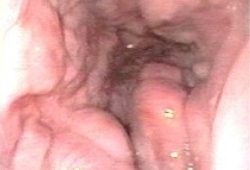Summary
Definition
History and exam
Key diagnostic factors
- presence of risk factors for variceal bleeding
- haematemesis
- melaena
- haematochezia
- cirrhosis
- severe liver disease
- alcohol misuse
- intravenous drug use
- hepatitis B or hepatitis C infection
- ascites
- spider angioma
- caput medusa
- jaundice
- encephalopathy
- HIV co-infection
Other diagnostic factors
- splenomegaly
Risk factors
- portal hypertension
- large varices
- red wale marks
- decompensated cirrhosis
- ascites
Diagnostic investigations
1st investigations to order
- gastroscopy
- full blood count
- electrolytes
- serum LFTs
- serum urea and creatinine
- coagulation profile (INR/prothrombin time)
- blood typing/cross-matching
- hepatitis B surface antigen (HBsAg)
- anti-hepatitis C virus IgG (anti-HCV IgG)
Investigations to consider
- capsule endoscopy
- liver ultrasound
Treatment algorithm
acute variceal bleeding
no acute variceal bleeding: medium to large varices
no acute variceal bleeding: small varices
previous variceal bleed
Contributors
Expert advisers
Joe Geraghty, BSc (Hons), MB BS (Dist), MRCP, PhD
Consultant Gastroenterologist
Department of Gastroenterology
Manchester Royal Infirmary
Central Manchester University Hospitals NHS Foundation Trust
Manchester
UK
Disclosures
JG declares that he has no competing interests.
Acknowledgements
BMJ Best Practice would like to gratefully acknowledge the previous expert contributor, whose work has been retained in parts of the content:
Grace E. Dolman, PhD, MA (Cantab), MRCP
Clinical Research Fellow
Barts Liver Centre
Barts and the London School of Medicine and Dentistry
London
UK
Disclosures
GED declares that she has no competing interests.
Peer reviewers
Andrew Austin, PhD, FRCP
Consultant Hepatologist
Lead Clinician in Gastroenterology
Royal Derby Hospital
Derby
UK
Disclosures
AA declares that he has no competing interests.
References
Key articles
Tripathi D, Stanley AJ, Hayes PC, et al. UK guidelines on the management of variceal haemorrhage in cirrhotic patients. Gut. 2015 Nov;64(11):1680-704.Full text Abstract
National Institute for Health and Care Excellence. Cirrhosis in over 16s: assessment and management. July 2016 [internet publication].Full text
de Franchis R, Bosch J, Garcia-Tsao G, et al. Baveno VII - Renewing consensus in portal hypertension. J Hepatol. 2022 Apr;76(4):959-74.Full text Abstract
Siau K, Hearnshaw S, Stanley AJ, et al. British Society of Gastroenterology (BSG)-led multisociety consensus care bundle for the early clinical management of acute upper gastrointestinal bleeding. Frontline Gastroenterol. 2020 Mar 27;11(4):311-23.Full text Abstract
National Institute for Health and Care Excellence. Acute upper gastrointestinal bleeding in over 16s: management. August 2016 [internet publication].Full text
Reference articles
A full list of sources referenced in this topic is available to users with access to all of BMJ Best Practice.

Differentials
- Hiatal hernia
- Gastric varices
- Mallory-Weiss tear
More DifferentialsGuidelines
- Acute upper gastrointestinal bleeding in over 16s: management
- UK guidelines on the management of variceal haemorrhage in cirrhotic patients
More GuidelinesCalculators
Blatchford Score for Gastrointestinal Bleeding
Rockall Score for Upper Gastrointestinal Bleeding
More CalculatorsPatient information
Hepatitis C: what treatments work?
Hepatitis B: should I have the vaccine?
More Patient informationLog in or subscribe to access all of BMJ Best Practice
Use of this content is subject to our disclaimer